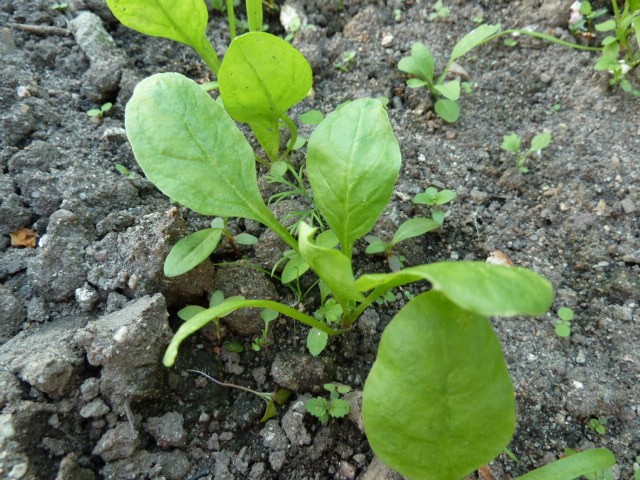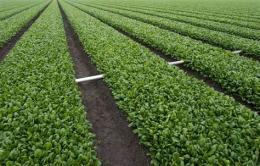Search
Login
Recommended
Vegetable king - spinach, on its own site
According to the assumptions, the discovery of spinach is due to one Frenchman who had a stomachache for a long time. Once, during a walk, he accidentally came across a thicket of little-known, at that time, spinach.
The Frenchman pinched a leaf and ate it. He liked the green juicy leaf, leaving a pleasant sensation and he began to use it daily, and soon discovered that his stomach did not bother him. Healing was attributed to a wonderful plant.
Content
- Spinach Overview video
- Growing Features
- Agricultural technology
- Sowing
- Care
- Harvest
- Food use
- The healing properties of spinach
- Limit the use of spinach
Spinach Overview
Vegetable spinach originated from wild growing in Asia Minor. This is an annual herbaceous plant whose root system is poorly developed, the bulk of the roots is at a depth of 25 cm.
During growth, at first a rosette is formed of 10-12 raised or horizontal leaves of a spear-shaped, ovoid or rounded shape.
This is a dioecious, dioecious plant, although, at times, monoecious are also found.
Male plants form fewer leaves, and female plants form larger leaves.
At the time of the plant reaching technical ripeness, the stem lengthens, lateral shoots, and then flowers, appear from the axils of the leaves.
Growing Features
Spinach is a rather precocious crop; the period from seedlings to technical ripeness is only 25-40 days. If you need to get the seeds, leave the bush and after 80-100 days the seeds are ready.

This plant tolerates frosts of up to 8 degrees Celsius, prefers cool weather. Spinach is unpretentious, but the best mass gain of leaves occurs on soils rich in organic substances, with a reaction close to neutral (pH6-7).
Loams rich in minerals and silty soils are quite suitable for growing spinach. On acidic soil, at a pH below 5.5, the plant develops poorly, and at pH 4.5 it dies in the seedling stage.
This culture is moisture-loving, lack of moisture in the soil and dry air contributes to rapid aging. A good crop can be obtained by sowing in early spring and autumn, in summer, especially in hot weather, it grows poorly.

Spinach responds well to organic and mineral nutrition, but the introduction of fresh manure is contraindicated, it is better to introduce manure under the previous crop. In the year of planting, it is preferable to make peat, humus or compost.
Agricultural technology
accommodation
This plant develops well in a lighted place, protected from the winds.

In agricultural technology, spinach is most often sown in early spring, as a precursor to late-planted heat-loving crops (cucumber, tomato), or in the summer, after harvesting early ripe crops (radishes, lettuce). This culture can be sown as a sealant to carrots or parsley.
seedbed preparation
Before sowing, the largest seeds are selected.

To prevent diseases, for prevention, the seeds are soaked in a slightly pink solution of potassium permanganate or in a solution of epin, or immunocytophyte.
soil preparation
In the fall, carefully, dig the soil onto the bayonet of a shovel, choose the rhizomes of perennial weeds, make 5-6 kg. compost or humus per square meter.
For peaty soils, it is enough to add 200 grams per square meter of ash.

On poor soils, in addition, from autumn 15-20 grams of double superphosphate and 10-15 grams of potassium chloride per square meter are applied, fertilizers are embedded in the soil.
the best varieties and hybrids
Early: gigantic, sturdy, F1 space, F1 stoic, sporter.
Mid-season: Dolphin RZ, greasy, spokane F1, matador.
Late ripe: Varangian, Victoria.
Sowing
Spinach is sown in several periods, observing an interval of 20-30 days. Frost-resistant varieties, in the rosette phase, overwinter, and in early spring they start to grow. For summer sowing, ripe, long-not-shoot varieties are used.

Spinach is sown in rows, into grooves after 15-20 centimeters. During sowing, the seeds are laid out along the bottom of the furrow after 2-5 centimeters and are covered with loose earth.
When sowing spinach in a continuous way, the yield is higher, it ripens 2-4 days earlier, but it is more difficult to take care of such crops. The sowing depth should not exceed 3 centimeters on heavy soil and 4 centimeters on light soil.
In order to avoid sticking out seeds from the soil, it is recommended to roll the soil after sowing.
Care
As soon as the shoots appear, in the phase of the first true leaf, they are thinned out, leaving rows with row spacings of 8-10 centimeters.

After emergence, rarely, but abundantly watered, wetting the soil to a depth of 10 centimeters. With weakened growth, watering is combined with top dressing, but does not exceed the norm of nitrogen, since the leaves accumulate nitrates.
To reduce the accumulation of nitrates, nitrogen feeding is combined with phosphorus, potassium and molybdenum.
Harvest
When the plants completely form a rosette of leaves, they are removed. It is better to clean greens chilled, i.e. in the evening or in the morning.

With continuous crops, the spinach is mowed, with manual harvesting, the plants are pulled out with the root. Spinach retains its presentation for 5-7 days, at a low positive temperature and a relative humidity of 95%.
Plants, late autumn harvest, are frozen with whole bundles. In winter, before use, put in cold water, where the greens restores its original form.
Food use
Fresh leaves of young plants are used for food. Leaves are added to omelets, cabbage soup, pasta, mashed potatoes, puddings, casseroles.

But you should know that you can’t store spinach dishes, the best option is to use freshly prepared. Limitations are due to the fact that at room temperature, within 1-2 days, nitrate salts are formed, they are absorbed into the blood and disrupt tissue respiration.
Spinach leaves are frozen, dried and canned.
The healing properties of spinach
Spinach has great advantages, since the substances found in spinach leaves remove toxins from the human body, heavy metals, cholesterol, and have a laxative effect.
Spinach contains vitamin D, it has an anti-rheumatic effect, and chlorophyll, in chemical composition, is close to blood hemoglobin, so spinach is a valuable product in diet and baby food.
In the treatment of anemia, vitamin deficiency, improve digestion and strengthen the work of the heart - spinach has long been used.
Spinach juice normalizes metabolism, improves well-being.
Limitations in the Use of Spinach
With a disease of the liver, kidneys and gout, it is undesirable to use it fresh.





